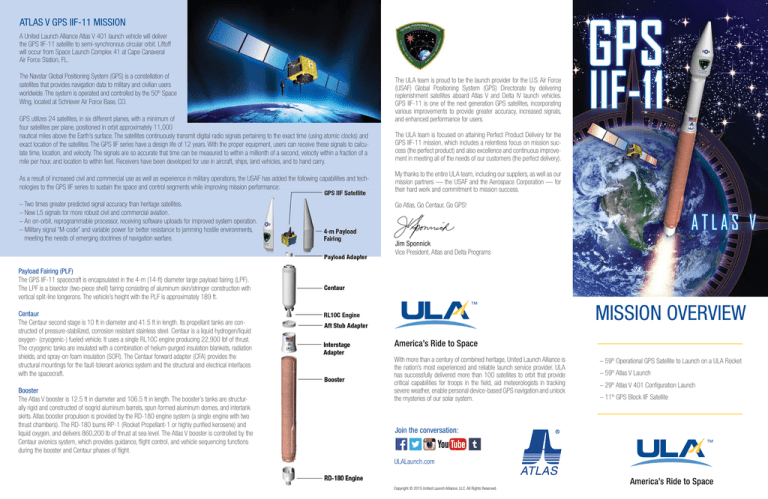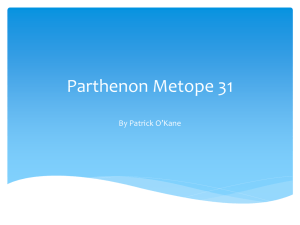
ATLAS V GPS IIF-11 MISSION
A United Launch Alliance Atlas V 401 launch vehicle will deliver
the GPS IIF-11 satellite to semi-synchronous circular orbit. Liftoff
will occur from Space Launch Complex 41 at Cape Canaveral
Air Force Station, FL.
The Navstar Global Positioning System (GPS) is a constellation of
satellites that provides navigation data to military and civilian users
worldwide. The system is operated and controlled by the 50th Space
Wing, located at Schriever Air Force Base, CO.
GPS utilizes 24 satellites, in six different planes, with a minimum of
four satellites per plane, positioned in orbit approximately 11,000
nautical miles above the Earth’s surface. The satellites continuously transmit digital radio signals pertaining to the exact time (using atomic clocks) and
exact location of the satellites. The GPS IIF series have a design life of 12 years. With the proper equipment, users can receive these signals to calculate time, location, and velocity. The signals are so accurate that time can be measured to within a millionth of a second, velocity within a fraction of a
mile per hour, and location to within feet. Receivers have been developed for use in aircraft, ships, land vehicles, and to hand carry.
As a result of increased civil and commercial use as well as experience in military operations, the USAF has added the following capabilities and technologies to the GPS IIF series to sustain the space and control segments while improving
ing mission performance:
– Two times greater predicted signal accuracy than heritage satellites.
– New L5 signals for more robust civil and commercial aviation.
– An on-orbit, reprogrammable processor, receiving software uploads for improved system
stem operation.
– Military signal “M-code” and variable power for better resistance to jamming hostile environments,
meeting the needs of emerging doctrines of navigation warfare.
The ULA team is proud to be the launch provider for the U.S. Air Force
(USAF) Global Positioning System (GPS) Directorate by delivering
replenishment satellites aboard Atlas V and Delta IV launch vehicles.
GPS IIF-11 is one of the next generation GPS satellites, incorporating
various improvements to provide greater accuracy, increased signals,
and enhanced performance for users.
The ULA team is focused on attaining Perfect Product Delivery for the
GPS IIF-11 mission, which includes a relentless focus on mission success (the perfect product) and also excellence and continuous improvement in meeting all of the needs of our customers (the perfect delivery).
My thanks to the entire ULA team, including our suppliers, as well as our
mission partners — the USAF and the Aerospace Corporation — for
th
their hard work and commitment to mission success.
Go Atlas, Go Centaur, Go GPS!
G
J Sponnick
Jim
VVice President, Atlas and Delta Programs
Payload Fairing (PLF)
The GPS IIF-11 spacecraft is encapsulated in the 4-m (14-ft) diameter large payload fairing (LPF).
The LPF is a bisector (two-piece shell) fairing consisting of aluminum skin/stringer construction with
vertical split-line longerons. The vehicle’s height with the PLF is approximately 189 ft.
Centaur
The Centaur second stage is 10 ft in diameter and 41.5 ft in length. Its propellant tanks are constructed of pressure-stabilized, corrosion resistant stainless steel. Centaur is a liquid hydrogen/liquid
oxygen- (cryogenic-) fueled vehicle. It uses a single RL10C engine producing 22,900 lbf of thrust.
The cryogenic tanks are insulated with a combination of helium-purged insulation blankets, radiation
shields, and spray-on foam insulation (SOFI). The Centaur forward adapter (CFA) provides the
structural mountings for the fault-tolerant avionics system and the structural and electrical interfaces
with the spacecraft.
Booster
The Atlas V booster is 12.5 ft in diameter and 106.5 ft in length. The booster’s tanks are structurally rigid and constructed of isogrid aluminum barrels, spun-formed aluminum domes, and intertank
skirts. Atlas booster propulsion is provided by the RD-180 engine system (a single engine with two
thrust chambers). The RD-180 burns RP-1 (Rocket Propellant-1 or highly purified kerosene) and
liquid oxygen, and delivers 860,200 lb of thrust at sea level. The Atlas V booster is controlled by the
Centaur avionics system, which provides guidance, flight control, and vehicle sequencing functions
during the booster and Centaur phases of flight.
MISSION OVERVIEW
W more than a century of combined heritage, United Launch Alliance is
With
th
the nation’s most experienced and reliable launch service provider. ULA
ha
has successfully delivered more than 100 satellites to orbit that provide
cr
critical capabilities for troops in the field, aid meteorologists in tracking
se
severe weather, enable personal device-based GPS navigation and unlock
th
the mysteries of our solar system.
Join the conversation:
ULALaunch.com
Copyright © 2015 United Launch Alliance, LLC. All Rights Reserved.
Co
– 59th Operational GPS Satellite to Launch on a ULA Rocket
– 59th Atlas V Launch
– 29th Atlas V 401 Configuration Launch
– 11th GPS Block IIF Satellite
ATLAS V PRODUCTION AND LAUNCH
MISSION PROFILE AND GROUND TRACE
1 Denver, CO
– ULA Headquarters & Design
Center Engineering
8
6
5
2 Harlingen, TX
– Payload Fairing, Boattail, Centaurr
Forward Adapter, Aft Stub Adapter,
er, &
Launch Vehicle Adapter Fabrication
ion
3 Decatur, AL
– Booster Fabrication & Final Assembly,
embly,
Centaur Tank Fabrication & Centaur
taur
Final Assembly
4 West Palm Beach, FL
– RL10C Engine Fabrication at Aerojet
rojet
Rocketdyne
5 Khimki, Russia
– RD-180 Engine Fabrication at NPO
Energomash
Event
4
3 Vertical Integration Facility | Launch vehicle Integration
and testing, spacecraft mate and integrated operations
Interstage
Adapter
2
3
3 Bridge Crane
4 Launch Vehicle
Booster
1
1.1
00:00:01.1
Begin Pitch/Yaw Maneuver
17.3
00:00:17.3
Mach 1
78.5
00:01:18.5
Maximum Dynamic Pressure
90.2
00:01:30.2
Atlas Booster Engine Cutoff (BECO)
243.8
00:04:03.8
Atlas Booster/Centaur Separation
249.8
00:04:09.8
3
Centaur Main Engine Start (MES-1)
259.8
00:04:19.8
4
Payload Fairing Jettison
267.8
00:04:27.8
5
Centaur First Main Engine Cutoff (MECO-1)
1,022.5
00:17:02.5
6
Centaur Second Main Engine Start (MES-2)
11,820.8
03:17:00.8
7
Centaur Second Main Engine Cutoff (MECO-2)
11,907.8
03:18:27.8
8
GPS IIF-11 Separation
12,193.8
03:23:13.8
Longitude (deg)
6 Centaur LO2 Storage
Centaur
Liftoff (Thrust to Weight > 1)
Perigee Altitude: 11,047 nmi | Apogee Altitude: 11,047 nmi | Inclination: 55.0 deg | Flight Azimuth: 45.8 deg
2
5 Mobile Launch Platform (MLP)
-00:00:02.7
2
1 Vertical Integration Facility (VIF)
(See inset)
2 Bridge Crane Hammerhead
-2.7
4
8 Booster LO2 Storage
80
5
7 High Pressure Gas Storage
60
5
9 Pad Equipment Building (PEB)
10 Pad ECS Shelter
Spacecraft
4-m Payload
Fairing Halves
40
BOSS
20
ER
5
LION
Guam
0
TDRS 046
TDRS 041
Diego Garcia
Payload
Transporter
1
-20
-40
2
1
4
-60
10
3
Telemetry Ground Station
Launch Vehicle /Spacecraft Ground Trace
TDRS Asset Geostationary Orbital Position
-80
6
Mobile
Launch
Platform
6 7 8
-135
7
Space Launch Complex 41
-90
-45
0
45
90
135
8
9
All Values Approximate
Geodetic Latitude (deg)
nter (ASOC) | LLaunch
aunch
1 Atlas Spaceflight Operations Center
Control Center and Mission Director’s Center
2 Spacecraft Processing Facility | Spacecraft processing,
testing and encapsulation
Time
(hr:min:sec)
RD-180 Engine Ignition
1
3
Time
(seconds)


